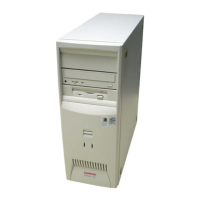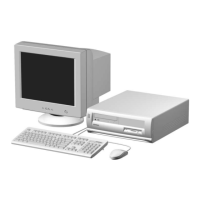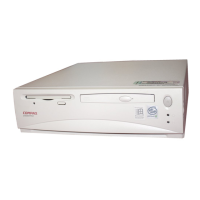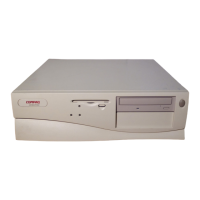Chapter 3 Processor/Memory Subsystem
3-4 Compaq Deskpro EP Series of Personal Computers
First Edition - April 1998
3.2.3 PROCESSOR CHANGING/UPGRADING
The slot 1 design allows for easy changing and/or upgrading of the microprocessor/cache
complex.
NOTE:
The Celeron processor-based system board employs retention uprights
specifically designed for the Celeron processor board. The Pentium II processor-based
system board
can functionally accept
the Celeron processor although the cartridge-
retention uprights
will
not
hold the Celeron processor board securely and could cause
problems if the system unit is moved. The board retainers on the Celeron processor-
based system board
will not
accept the Pentium II SEC cartridge.
In changing the processor, two key areas (aside from the physical limitations previously
described) should be considered: thermal characteristics and operating speed (core voltage is
automatically set by the processor as discussed in chapter 6).
Thermal Considerations
The factory-installed processor includes a passive heat sink. The processor includes an internal
temperature sensor that will shut down the CPU if the cartridge overheats. When the processor
temperature reaches 135° C the processor will assert the THERMTRIP signal that system board
logic uses to shut down the clock generator. The THERMTRIP signal is also used to activate the
circuit that causes the power LED to blink at 4 Hz, indicating the excessive heat condition.
Upgrade processors may include a fan-cooled heat sink.
Processor Speed Selection
Changing the processor may require re-configuration of the bus/core frequency ratio. The 66-
MHz slot 1system board includes a six-position DIP switch (SW), of which four positions are
used to select the bus-to-core frequency ratio of the processor. Table 3-2 shows the possible
switch configurations for this system and the resultant core (or processing) frequency, based on
the bus frequency.
Table 3–2.
Pentium II COVINGTON Processor Bus/Core Speed Switch Settings
Table 3-2.
66-MHz Slot 1 System Board
Bus/Core Speed Switch Settings
DIP SW1 Settings
2 3 4 5 [1]
Bus/Core
Freq. Ratio
Core Frequency
(66 MHz Host Bus)
1 1 0 0 2/7 233
0 0 1 0 1/4 266
0 1 1 0 2/9 300
1 0 1 0 1/5 333
The processor sets the clock generator to the appropriate bus frequency. Software can determine
the operating speed by reading the bus-to-core frequency ratio and the bus speed from an MSR
register in the processor.
NOTE:
Shipping configurations are unshaded. DIP
switches should be set to match the
processor installed. Configuring for a speed
higher than that which the processor is
designed could result in unreliable operation
and possible system damage.
[1] 0 = Switch closed (On)
1 = Switch open
Off

